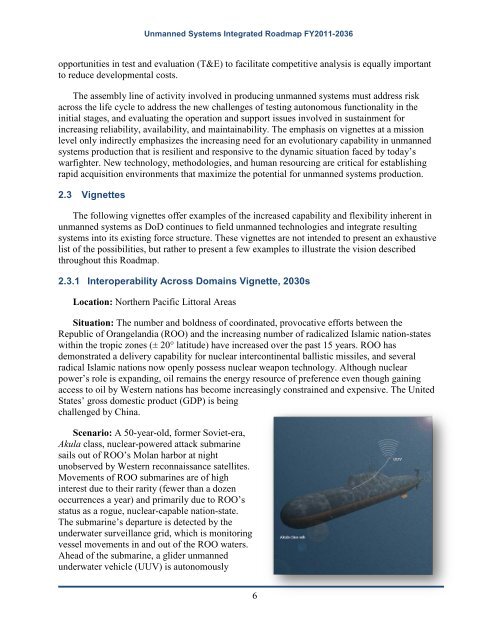Unmanned Systems Integrated Roadmap FY2011-2036 - Defense ...
Unmanned Systems Integrated Roadmap FY2011-2036 - Defense ...
Unmanned Systems Integrated Roadmap FY2011-2036 - Defense ...
Create successful ePaper yourself
Turn your PDF publications into a flip-book with our unique Google optimized e-Paper software.
<strong>Unmanned</strong> <strong>Systems</strong> <strong>Integrated</strong> <strong>Roadmap</strong> <strong>FY2011</strong>-<strong>2036</strong><br />
opportunities in test and evaluation (T&E) to facilitate competitive analysis is equally important<br />
to reduce developmental costs.<br />
The assembly line of activity involved in producing unmanned systems must address risk<br />
across the life cycle to address the new challenges of testing autonomous functionality in the<br />
initial stages, and evaluating the operation and support issues involved in sustainment for<br />
increasing reliability, availability, and maintainability. The emphasis on vignettes at a mission<br />
level only indirectly emphasizes the increasing need for an evolutionary capability in unmanned<br />
systems production that is resilient and responsive to the dynamic situation faced by today’s<br />
warfighter. New technology, methodologies, and human resourcing are critical for establishing<br />
rapid acquisition environments that maximize the potential for unmanned systems production.<br />
2.3 Vignettes<br />
The following vignettes offer examples of the increased capability and flexibility inherent in<br />
unmanned systems as DoD continues to field unmanned technologies and integrate resulting<br />
systems into its existing force structure. These vignettes are not intended to present an exhaustive<br />
list of the possibilities, but rather to present a few examples to illustrate the vision described<br />
throughout this <strong>Roadmap</strong>.<br />
2.3.1 Interoperability Across Domains Vignette, 2030s<br />
Location: Northern Pacific Littoral Areas<br />
Situation: The number and boldness of coordinated, provocative efforts between the<br />
Republic of Orangelandia (ROO) and the increasing number of radicalized Islamic nation-states<br />
within the tropic zones (± 20° latitude) have increased over the past 15 years. ROO has<br />
demonstrated a delivery capability for nuclear intercontinental ballistic missiles, and several<br />
radical Islamic nations now openly possess nuclear weapon technology. Although nuclear<br />
power’s role is expanding, oil remains the energy resource of preference even though gaining<br />
access to oil by Western nations has become increasingly constrained and expensive. The United<br />
States’ gross domestic product (GDP) is being<br />
challenged by China.<br />
Scenario: A 50-year-old, former Soviet-era,<br />
Akula class, nuclear-powered attack submarine<br />
sails out of ROO’s Molan harbor at night<br />
unobserved by Western reconnaissance satellites.<br />
Movements of ROO submarines are of high<br />
interest due to their rarity (fewer than a dozen<br />
occurrences a year) and primarily due to ROO’s<br />
status as a rogue, nuclear-capable nation-state.<br />
The submarine’s departure is detected by the<br />
underwater surveillance grid, which is monitoring<br />
vessel movements in and out of the ROO waters.<br />
Ahead of the submarine, a glider unmanned<br />
underwater vehicle (UUV) is autonomously<br />
6

















